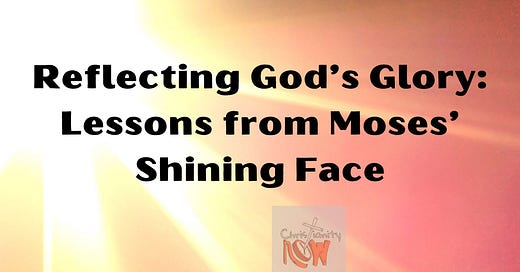Reflecting God’s Glory
Lessons from Moses’ Shining Face
The account of Moses’ shining face upon descending Mount Sinai, as recorded in the Book of Exodus, offers insights into the dynamics of divine presence, human intuition, and the nature of denial. These themes are not only foundational to understanding one’s spiritual journey but also illuminate the interaction between the divine and the human in the Biblical narrative. Here, we will delve into three specific lessons derived from this pivotal moment in Scripture.
The Necessity of Continual Communion with God
When Moses returned from Mount Sinai, his face shone because he had spoken with the Lord (Exodus 34:29). This radiance, however, faded over time, symbolizing the decrease in divine influence when one distances oneself from God. This physical change in Moses vividly illustrates a spiritual principle: proximity to and communion with God endow individuals with a reflective glory that diminishes upon withdrawal.
The Apostle Paul expounds on this principle in his second epistle to the Corinthians, contrasting the fading glory of Moses’ covenant with the enduring glory of the new covenant through Christ (2 Corinthians 3:7-18). Paul’s discourse suggests that unlike the old covenant, which loses its brilliance, the new covenant sustains its followers through continual renewal. This comparison emphasizes the importance of regular engagement with God to maintain spiritual vigor and transformation.
Human Intuition in Recognizing Spiritual Truths
The response of the Israelites to Moses’ radiant face reveals an intuitive understanding of the transient nature of the old covenant. Despite the brilliance that Moses' face exhibited, the people were aware, even if subconsciously, that the glory was temporary. Paul uses this historical event as a metaphor in his letters to illustrate that the old covenant, signified by Moses, was never meant to be permanent but was to be superseded by a greater glory through Christ (2 Corinthians 3:13).
This recognition suggests that humans possess an innate capability to grasp deeper spiritual truths. The Israelites were able to discern the symbolic nature of the fading glory of Moses’ face, understanding that it reflected the eventual diminishing relevance and efficacy of the Mosaic Law.
The Human Tendency to Deny Uncomfortable Truths
Moses' decision to veil his face can be interpreted as a metaphor for human tendencies to avoid confronting or acknowledging truths that require personal change or which challenge existing beliefs (Exodus 34:33-35). Paul remarks on this in his epistle, noting that the Israelites' minds were hardened, and to this day, a veil lies over their heart when they hear the old covenant read (2 Corinthians 3:14-16).
This behavior illustrates a broader human inclination to deny reality, preferring to remain in a state of ignorance rather than face potentially disruptive truths. Paul points out that it is only through turning to the Lord that this veil is lifted, enabling individuals to confront and embrace the truth as it is in Jesus Christ.
Conclusion
The narrative of Moses’ shining face is rich with lessons on maintaining a vibrant spiritual life, recognizing inherent understandings of divine truths, and confronting the often-uncomfortable realities of spiritual demands. These insights encourage believers to seek a closer relationship with God, embrace fuller understandings of His word, and face with courage the truths that necessitate personal and communal transformation. By reflecting on these themes, one can better navigate the complexities of faith and the challenges of living a life aligned with divine will.



